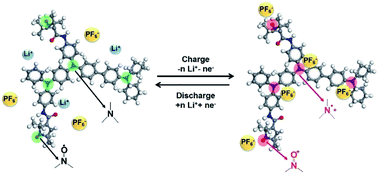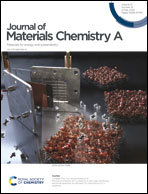Emerging conjugated radical polymer cathodes with ultra-long cycle life for an entire polymer rechargeable battery†
Abstract
Entire polymer rechargeable batteries (EPRBs) have attracted extensive attention as a sustainable energy storage technology. However, p-type redox polymer cathodes with satisfactory cycling stability and rate capacity are still lacking; thus currently, few EPRB have been reported. Here, a conjugated radical copolymer containing nitroxide radicals and triphenylamine radicals with a crosslinking structure is proposed. Due to the synergistic effects from the conjugated backbone and the radical pendants, this copolymer can deliver an initial reversible capacity of 131 mA h g−1, high discharge voltage of 3.7 V and ultra-long cycle life with 72% capacity retention at 2000 mA g−1 after 3000 cycles. Further, a novel EPRB consisting of a p-type conjugated radical copolymer cathode, typical n-type poly(anthraquinonyl sulfide) anode and microporous gel polymer electrolyte is demonstrated, which can yield an operation voltage of 1.8 V and a specific energy of 138 W h kg−1, especially, a favorable capacity retention of 82.1% after 1500 cycles at 20 mA g−1.



 Please wait while we load your content...
Please wait while we load your content...